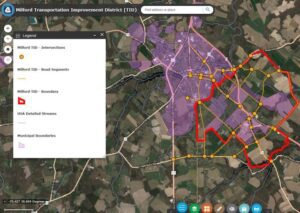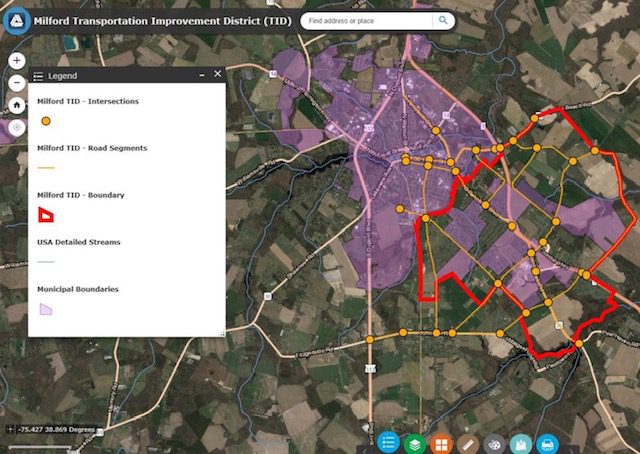

Milford City Council approved a fee schedule for the SE Milford Transportation Improvement District (TID)
Milford City Council approved a funding rate for the Southeast Milford Transportation Improvement District plan at a recent meeting. The plan will add 30 percent to building permit fees that will be used to offset the cost of improvements to roads in the Milford’s southeastern area. The plan, which includes additional traffic signals and roundabouts, was approved in 2021 and include $85 million in road upgrades.
Rob Pierce, City Planner, explained that all drawings presented to council were concept drawings and that formal design nor right-of-way needs had been established.
“Formal design and any right-of-way acquisition would be performed by DelDOT once it is determined these intersection improvements are warranted based on growth,” Pierce said. “None of the projects outlined in Milford’s TID are in the current DelDOT Capital Transportation Plan (CTP) and it could be several years before any of these projects begin construction or design.”
Pierce explained that the exact right-of-way extent of the TID improvements cannot be determined until surveying and more formal engineering of the facilities are completed, but based on the preliminary concept plans, no full acquisitions are anticipated for the S. Rehoboth Boulevard and Kirby Road intersection. There had been social media comments about a roundabout at this intersection with some residents concerned it could mean the loss of houses.
“There will be two proposed signals that will be installed, one at Johnson and Cedar Creek Road and the other at the northbound ramp off Route 1 and Cedar Neck Road,” Rob Pierce, City Planner, said. “There are also about eight roundabouts proposed at various locations. Some of the members of the public who I talked to before this. meeting had questions on the Corridor Capacity Preservation Program and its impacts on the local area.”
Sarah Coakley, Principal Planner with DelDOT provided details on the Corridor Capacity Preservation Program whose goal was to maintain capacity on Route 1 from Dover to Five Points.
“So this county and then all the way up to Dover basically is a route for regional traffic and then we try to maintain and build parallel routes to it for local traffic, basically, local and regional traffic separate and enable the local traffic to not have the experience of bottlenecks, number one, for them to have other ways of moving around on a daily basis and without being impacted by regional traffic shifts along Route 1,” Coakley said. “But the idea there is to maintain the through capacity, not see increases in delay along State Route 1. And we achieved that by building new roads and parallel like service roads to Route 1 with the points of access for the locals. For those, I think we had a public workshop back in November for that program. And we’re still getting on lots of comments on that. And we’re probably going to be doing more outreach on that program as well. Because we have been getting lots of inquiries and interest in learning more about it. So, we’re hoping to do more outreach on that before those plans are finalized.”
Pierce explained that some of the road changes were related to the capacity preservation program and that many of the proposed changes would still need to go through the formal engineering process. At the meeting, Pierce stated that council simply needed to decide if they wanted to add 30 percent or 35 percent as a TID fee for building permits pulled by developers. Councilman Todd Culotta commented that it appeared that the difference between a 30 and 35 percent fee would be about $500 per unit and Pierce confirmed that was correct. Based on information provided at the meeting, adding a 30 percent fee would mean developers would pay $2,750 for a single-family detached residential dwelling while at 35 percent, the cost would increase to $3,250.
“I asked the question about the average difference because $500 doesn’t sound ridiculous,” Councilman Culotta said. “But you know, these costs while they’re developer contributions, will be passed through to the homebuyer. So, oftentimes in this council, we talk about affordable housing, what we can do to help that these are the little things that add to that. We just have to think about it. I can be convinced either way on the 30 or 35 percent. But it’s just not simply ‘Hey, it’s just a little bit more for developers no big deal.’ It does get passed through to the homeowner, it does impact the house cost.”
Coakley explained that Newark’s rate for their TID was 25 percent and Middletown was 30 percent, indicating that 35 percent would be on the higher side. Mike Ryman of Becker Morgan spoke during the public hearing portion of the discussion.
“We are extremely supportive of TIDs in general concept they are ultimately a better way to plan improvement and growth areas to better match with growth in local area,” Ryman said. “So, all fully supportive of the program. I will say what this will accomplish is allow DelDOT to more cohesively implement improvements as opposed to, I’ll call it developers piecemealing improvements. There’s lots of examples of those situations throughout the state where five or six different developers are widening five or six different sections of road and you really don’t end up with a good product or as good of a product as you could get as DelDOT would cohesively do this by collecting the necessary funding. So there’s no question that TIDs in general are the way to go.”
Ryman was concerned about the TID fee at 35 percent as opposed to 30 percent, however.
“I think you heard Sarah say that 35% would be higher than everyone with the exception of the Southern Newcastle County which is 50%. And that is because the entrance improvements themselves are baked in and that’s why it’s so much higher as compared to here,” Ryman said. “Whereas the developers would still be responsible to construct the entrances. So I will leave you with one statistic just for consideration to kind of pick up on Councilman Culotta’s point is, and this is a statistic from the National Association of Homebuilders. For every $1,000 that you raise the price of a house nationally 118,000 people are kicked out of the ability to afford a mortgage. So, all of these $500 here, $1000 there dollars definitely impact the public and they add up. Our position would be that if 30% gets the job done and that is what is necessary to implement these improvements as has been determined, then we should try to keep the cost as minimal as possible to get the improvements done and I would urge the council to seriously consider keeping it 30% Which is more consistent with the other TIDs in the state.”
Ryman also pointed out that these fees did not just impact single-family development.
“They also affect social and economic development projects that that you are hoping to attract within the city,” Ryman said. “Keep in mind that there are other rates in there that are based on per square foot. So, it’s not just the single family side that are having to pay these costs.”
Councilman Brian Baer asked if there were grants available for some of the projects to which Coakley explained that there were grants, especially for the transportation alternatives programs.
“That provides a separate specific pool of federal highway funding that can only be used for bicycle and pedestrian improvements,” Coakley said. “So, most of the improvements in your city’s bicycle plan would be eligible for that program. I think those funds can cover up to $1 million at a time, including design and construction. So, those improvements in the TID may be eligible for other funding sources as well.”
Councilman Baer asked if DelDOT applied for those grants and Coakley said that local governments usually do that. Council approved the 30 percent fee with a vote of five to zero. Councilwomen Nirmala Samaroo and Katrina Wilson were not present for the vote.
Share this Post



